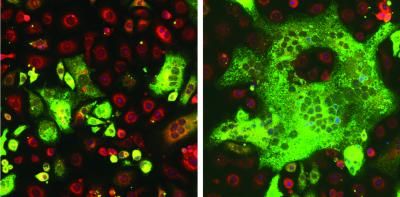Pushing the boundaries
Johns Hopkins study provides key insight into how cells fuse
Advertisement
Researchers at Johns Hopkins have established a high-efficiency cell-cell fusion system, providing a new model to study how fusion works. The scientists showed that fusion between two cells is not equal and mutual as some assumed, but, rather, is initiated and driven by one of the fusion partners. The discovery, they say, could lead to improved treatments for muscular dystrophy, since muscle regeneration relies on cell fusion to make muscle fibers that contain hundreds or even thousands of nuclei.

When the fusogenic protein Eff-1 was expressed, a few normally nonfusing cells merged (left). But when Eff-1 was expressed with a protein that could organize cytoskeleton remodeling, fusion was rampant, leading to the formation of giant cells with many nuclei (right).
AAAS
The study reveals two critical components that have to be present for cell fusion to happen, explains Elizabeth Chen, Ph.D., an associate professor of molecular biology and genetics in the Johns Hopkins University Institute for Basic Biomedical Sciences. Intriguingly, she says, one of these vital components actually changes the structure of one cell's scaffolding — its cytoskeleton — to form protrusions that push their way into the other cell to initiate fusion.
Chen's research group had seen this before; using very high-resolution electron microscopy, they showed in 2010 that in developing fly muscles, a muscle cell merges with another muscle cell by extending finger-like protrusions into its fusion partner. But cell fusion is not only behind muscle building, but also fertilization (sperm fuses with egg), placenta formation, bone development and immune response. Thus, Chen says, it wasn't clear whether the finger-like protrusions were present for fusion outside of muscles, or if protrusions really drove the fusion process.
To study fusion in a simple system designed to answer those questions, Chen and her group wanted to establish a culture of fusing cells, starting from a cell line made up of nonmuscle fly cells. These cultured cells weren't of a type that normally fuses, so the group tried modifying them with proteins that were thought to be important for muscle cell fusion in fruit flies. Alone and in combination, however, those proteins failed to entice the cells to fuse. The researchers were stuck, Chen said.
Then they learned about another group's finding in a tiny worm called C. elegans: a protein called Eff-1 that localized on the cell's outer skin, or membrane, and could induce cell-cell fusion not only in the worm, but also in cultured moth cells. When Chen's group introduced Eff-1 into their fly cells, only about 10 percent of the cells fused. But when they introduced both Eff-1 and a fly protein that could organize cytoskeleton remodeling, "almost 90 percent of the cells started to fuse," Chen said. "We had our system."
"Reconstructing high-efficiency cell fusion outside of a living organism allows us to observe the process in unprecedented detail and deduce general principles underlying cell-cell fusion," Chen notes. One of her group's first discoveries with the new system was that Eff-1 clusters along the finger-like protrusions, where the two fusion partners are in close contact. "This suggests to us that one of the purposes of the invasive fingers is to engage fusogenic proteins in both cells," Chen explains. "We are excited about this finding since it reveals, for the first time, an intimate coordination between the actin cytoskeleton-propelled membrane protrusions and fusogenic proteins, a principle that will likely apply to other types of cell fusion events as well."
The insights from this study raise many new questions, and Chen says the cell culture system will be a major help in her and other scientists' continued study of cell fusion. With enough knowledge of the process, researchers may be able to optimize cell-based treatments for muscular dystrophy, in which normal muscle cells are transplanted into a patient and then fuse to repair damaged muscle fibers.
















































